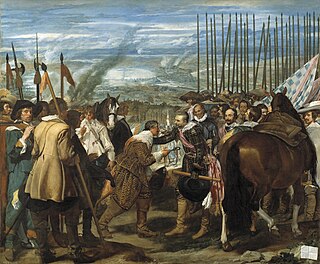
The 16th century began with the Julian year 1501 and ended with either the Julian or the Gregorian year 1600 (MDC), depending on the reckoning used.

1644 (MDCXLIV) was a leap year starting on Friday of the Gregorian calendar and a leap year starting on Monday of the Julian calendar, the 1644th year of the Common Era (CE) and Anno Domini (AD) designations, the 644th year of the 2nd millennium, the 44th year of the 17th century, and the 5th year of the 1640s decade. As of the start of 1644, the Gregorian calendar was 10 days ahead of the Julian calendar, which remained in localized use until 1923.

1617 (MDCXVII) was a common year starting on Sunday of the Gregorian calendar and a common year starting on Wednesday of the Julian calendar, the 1617th year of the Common Era (CE) and Anno Domini (AD) designations, the 617th year of the 2nd millennium, the 17th year of the 17th century, and the 8th year of the 1610s decade. As of the start of 1617, the Gregorian calendar was 10 days ahead of the Julian calendar, which remained in localized use until 1923.

Year 1535 (MDXXXV) was a common year starting on Friday of the Julian calendar.
The 1520s decade ran from January 1, 1520, to December 31, 1529.

1600 (MDC) was a century leap year starting on Saturday of the Gregorian calendar and a leap year starting on Tuesday of the Julian calendar, the 1600th year of the Common Era (CE) and Anno Domini (AD) designations, the 600th year of the 2nd millennium, the 100th and last year of the 16th century, and the 1st year of the 1600s decade. As of the start of 1600, the Gregorian calendar was 10 days ahead of the Julian calendar, which remained in localized use until 1923.

1619 (MDCXIX) was a common year starting on Tuesday of the Gregorian calendar and a common year starting on Friday of the Julian calendar, the 1619th year of the Common Era (CE) and Anno Domini (AD) designations, the 619th year of the 2nd millennium, the 19th year of the 17th century, and the 10th and last year of the 1610s decade. As of the start of 1619, the Gregorian calendar was 10 days ahead of the Julian calendar, which remained in localized use until 1923.

1625 (MDCXXV) was a common year starting on Wednesday of the Gregorian calendar and a common year starting on Saturday of the Julian calendar, the 1625th year of the Common Era (CE) and Anno Domini (AD) designations, the 625th year of the 2nd millennium, the 25th year of the 17th century, and the 6th year of the 1620s decade. As of the start of 1625, the Gregorian calendar was 10 days ahead of the Julian calendar, which remained in localized use until 1923.

Year 1540 (MDXL) was a leap year starting on Thursday of the Julian calendar.

Year 1506 (MDVI) was a common year starting on Thursday of the Julian calendar.

The 1530s decade ran from January 1, 1530, to December 31, 1539.

1654 (MDCLIV) was a common year starting on Thursday of the Gregorian calendar and a common year starting on Sunday of the Julian calendar, the 1654th year of the Common Era (CE) and Anno Domini (AD) designations, the 654th year of the 2nd millennium, the 54th year of the 17th century, and the 5th year of the 1650s decade. As of the start of 1654, the Gregorian calendar was 10 days ahead of the Julian calendar, which remained in localized use until 1923.

Year 1528 (MDXXVIII) was a leap year starting on Wednesday of the Julian calendar, there is also a Leap year starting on Sunday of the Gregorian calendar.

Year 1559 (MDLIX) was a common year starting on Sunday of the Julian calendar.

Year 1551 (MDLI) was a common year starting on Thursday of the Julian calendar.

Year 1539 (MDXXXIX) was a common year starting on Wednesday of the Julian calendar.

Year 1529 (MDXXIX) was a common year starting on Friday of the Julian calendar.

Year 1526 (MDXXVI) was a common year starting on Monday of the Julian calendar.

Maximilian II was Holy Roman Emperor from 1564 until his death in 1576. A member of the Austrian House of Habsburg, he was crowned King of Bohemia in Prague on 14 May 1562 and elected King of Germany on 24 November 1562. On 8 September 1563, he was crowned King of Hungary and Croatia in the Hungarian capital Pressburg. On 25 July 1564, he succeeded his father Ferdinand I as Holy Roman Emperor.

Leopold I was Holy Roman Emperor, King of Hungary, Croatia, and Bohemia. The second son of Ferdinand III, Holy Roman Emperor, by his first wife, Maria Anna of Spain, Leopold became heir apparent in 1654 after the death of his elder brother Ferdinand IV. Elected in 1658, Leopold ruled the Holy Roman Empire until his death in 1705, becoming the second longest-ruling emperor of the House of Hapsburg. He was both a composer and considerable patron of music.
























